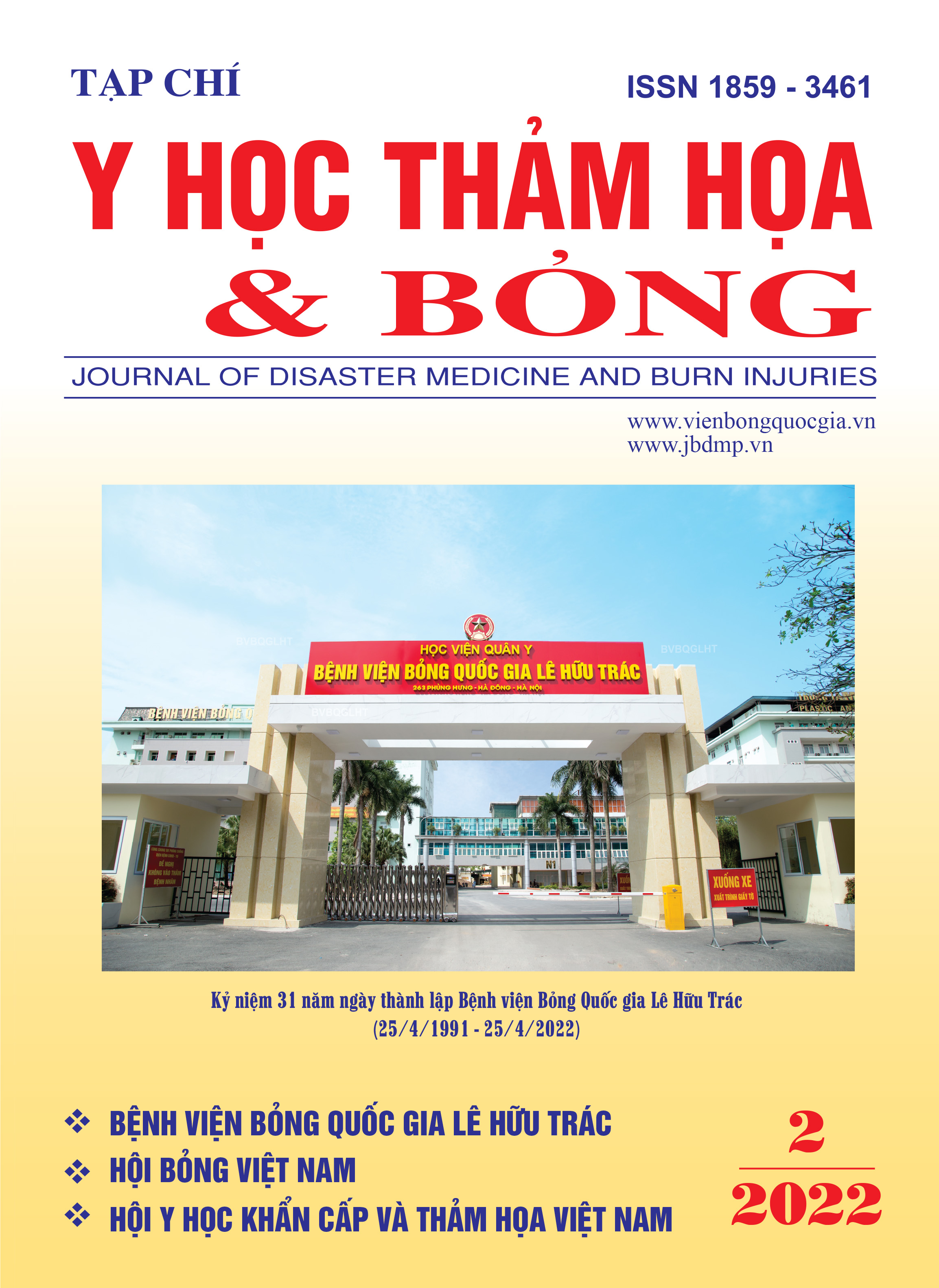Evaluation of skin irritation of nano Berberine gel in rabbits
Main Article Content
Abstract
Berberine was a compound found in Coscinium fenestratum and other Ranunculaceae plants that helps to heal wounds and burns. National Burn Hospital’s nano Berberine gel was studied to evaluate skin irritation in rabbits. The methodological research was carried out according to the guidelines of the Ministry of Health and OECD.
The gauze patch of 0.5g nano Berberine gel was applied to the appropriate healthy skin of 3 rabbits (2.5 x 2.5cm); after 4 hours by peeling off gauze and cleaning. Evaluation of activation index at 24, 48 and 72h after cleaning. The application index was 0 (no erythema, scab formation and edema in healthy rabbit skin). There were no dead rabbits, and the rabbits were still healthy.
Conclusion: On healthy rabbits’ skin, nano Berberine gel was safe and non-irritating.
Article Details
Keywords
Nano Berberine, Rabbits, Irritation
References
2. Yullya S. Mulyanti, Yuliarni, Busarin Kasemchainan, Partha P. Mitra, Paul Evans, Haryono Hartono. Evaluation of the Skin Irritation and Sensitization Potential of the Cussons Baby Sensicare Skin Range of Products in Healthy Volunteers, Journal of Cosmetics, Dermatological Sciences and Applications, Vol.9 No.3, September 2019
3. Bộ Y Tế (2015). Hướng dẫn thử nghiệm tiền lâm sàng và lâm sàng thuốc đông y, thuốc từ dược liệu, QĐ 141/BYT-QĐ.
4. Parth Patel; A bird's eye view on a therapeutically ‘wonder molecule’: berberine; phytomedicine plus; volume 1, issue 3, August 2021, 100070.
5. OECD (2002). OECD Guidelines for the Testing of Chemicals No. 404: Acute Skin Irritation/Corrosion. Paris, France: Organisation for Economic Cooperation and Development.
6. OECD/OCDE (2017). OECD guideline for the testing of chemicals; No 402; http://www.oecd.org/termsandconditions.
7. Bộ Y tế (1999); Phương pháp thử kích ứng trên da (áp dụng cho các sản phẩm dùng trong y tế và mỹ phẩm), (ban hành kèm theo quyết định số 3113/1999/QĐ-BYT ngày 11 tháng 10 năm 1999 của bộ trưởng).
8. Ana Gallegos Saliner, Grace Patlewicz & Andrew P. Worth (2007). Review of Literature-Based Models for Skin and Eye Irritation and Corrosion. European Communities.
9. Calabrese, E. J. (1984). Gastrointestinal and dermal absorption: Interspecies differences. Drug Metab Rev 15, 1013-32.
10. Sidon, E. W., Moody, R. P., Franklin, C. A. (1988). Percutaneous absorption of cis- and trans-permethrin in rhesus monkeys and rats: Anatomic site and interspecies variation. J Toxicol Environ Health 23, 207-16.
11. Scott, R. C., Corrigan, M. A., Smith, F., Mason, H. (1991). The influence of skin structure on permeability: An intersite and interspecies comparison with hydrophilic penetrants. J Invest Dermatol 96, 921-5.
12. Calvin, G. (1992). New approaches to the assessment of eye and skin irritation. Toxicol Lett. 64-65, 157-64.
13. Jírová, D., Basketter, D., Liebsch, M., Bendová, H., Kejlová, K., Marriott, M., Kandárová, H. (2010). Comparison of human skin irritation patch test data with in vitro skin irritation assays and animal data. Contact Dermatitis. 62, 109-16.
14. Cushman, J. R., Richter, W. R., Duke, J. T. (1989). Effects of skin sensitization test wrapping on guinea pigs. Contact Derm 21, 279-80.
15. Nyska, A., Waner, T., Wormser, U., Gur, E., Kuttin, E., Dayan, D. (1992). Possible pitfalls in rat extended dermal toxicity testing: An hepatic-ocular syndrome. Arch Toxicol 66, 339-46.
16. Parker, G. A., Gibson, W. B. (1995). Liver lesions in rats associated with wrapping of the torso. Toxicol Pathol 23, 507-12.
17. Ramot, Y., Rosenstock, M., Klinger, E., Bursztyn, D., Nyska, A., Shinar, D. M. (2012). Comparative long-term preclinical safety evaluation of two glatiramoid compounds (glatiramer Acetate, Copaxone(R), and TV-5010, protiramer) in rats and monkeys. Toxicol Pathol 40, 40-54.
18. Flarer Franco (1955). “The causes of inflammatory erythema”, J. Invest. Dermatol, Vol 24, pp. 201-209.
19. Jachim W. Fluhr, Darlenski R., Angelova - Fischer I. and et al (2008). “Skin Irritation and Sensitization: Mechanisms and New Approaches for Risk Assessment”, Skin Pharmacology and Physiology, Vol 21, pp. 124-135.
20. OECD (2010). Guidelines for the Testing of Chemicals: In Vitro Skin Irritation - Reconstructed Human Epidermis Test Method, Test No. 439.
21. Spencer T, Gorinshteyn B, Ganey T (2016). Efficacy and Safety of Berberex Wound Cleanser on Post-Operative Surgical Incisions. Clin Surg.; 1: 1196.
22. Mabrouk A, Boughdadi NS, Helal HA, et al (2012). Moist occlusive dressing (Aquacel Ag) versus moist open dressing (MEBO) in the management of partial-thickness facial burns: a comparative study in Ain Shams University. Burns; 38(3):396-403.
23. Atiyeh BS, Ghanimeh G, Kaddoura IL, et al (2001). Split-thickness skin graft donor site dressing: preliminary results of a controlled, clinical comparative study of MEBO and Sofra-Tulle. Ann Plast Surg.; 46(1):87-8.
24. Alsabbahi M, University Z (2019). Effect of Mebo Dressing Versus Standard Care on Managing Donor and Recipient Sites of Split-thickness Skin Graft (EMD-SCZ-SGS); ClinicalTrials.gov Identifier: NCT02737943 august 1990. [Available from OECD Secretariat upon request].
25. Tsugunobu Andoh et al. Berberine induces anti-atopic dermatitis effects through the downregulation of cutaneous EIF3F and MALT1 in NC/Nga mice with atopy-like dermatitis, Biochem Pharmacol. 2021 Mar., 185:114439.
26. Miranda S M Tsang et al, Anti-Inflammatory Activities of Pentaherbs Formula, Berberine, Gallic Acid and Chlorogenic Acid in Atopic dermatitis-like Skin Inflammation; Molecules. 2016. Apr 20;21(4):519.
27. Y Zhang et al. A preliminary study on the safety of berberine solution in rabbit eyes with topical application, Chin J Ophthalmol, 2020, 56: 131-137. 2020. Feb 11;56(2):131-137.doi: 10.3760/CMA.j.issn.0412-4081.2020.02.009.


